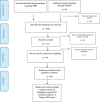Efficacy and Safety of Laser Therapy and Phototherapy in Cicatricial and NonCicatricial Alopecia: A Systematic Review Study
- PMID: 39502132
- PMCID: PMC11534645
- DOI: 10.1002/hsr2.70180
Efficacy and Safety of Laser Therapy and Phototherapy in Cicatricial and NonCicatricial Alopecia: A Systematic Review Study
Abstract
Background and aims: In recent years, the application of various light and laser devices in the treatment of different types of alopecia has been established. This systematic review aims to assess the efficacy and safety of laser therapy and phototherapy in cicatricial and non-cicatricial alopecia.
Methods: A comprehensive search was conducted on PubMed, Scopus, Science Direct, and Google Scholar. Articles were evaluated across four subgroups: alopecia areata, androgenic alopecia, telogen effluvium, and cicatricial alopecia. Included studies were published in English or Persian between January 2010 and September 2023, focusing on interventional, cohort, or case series research that achieved a minimum score of 75% on the EBL checklist. Exclusion criteria encompassed animal and in vitro studies, review articles, case reports, duplicated or irrelevant research, as well as studies that did not meet the designated EBL score. Editorial letters and case studies were also excluded.
Results: Initially, 965 records were collected, resulting in the inclusion of 58 studies in the final review: 26 on alopecia areata, 26 on androgenic alopecia, five on cicatricial alopecia, and one on telogen effluvium. Narrow-band ultraviolet B, 308-nm excimer laser, and psoralen ultraviolet A therapy showed varying effectiveness; specifically, the excimer laser was notably effective for patients with shorter disease duration. In androgenic alopecia, erbium-glass and thulium lasers effectively increased hair density but showed a gradual decline posttreatment. Low-level light/laser therapy also increased hair density and diameter and exhibited potential benefits when used alongside minoxidil, but did not significantly enhance outcomes in telogen effluvium treatment.
Conclusion: Light/laser therapy can serve as an additive treatment for cicatricial alopecia, particularly lichen planopilaris, but has limited efficacy in treating telogen effluvium. Overall, light/laser therapies exhibit a significant positive effect on increasing hair density and diameter across various alopecia types.
Keywords: alopecia; alopecia noncicatrisata; baldness; cicatrisata; low‐level light therapy; lupus erythematosus.
© 2024 The Author(s). Health Science Reports published by Wiley Periodicals LLC.
Conflict of interest statement
The authors declare no conflicts of interest.
Figures
References
-
- Gokalp H., Psychosocial Aspects of Hair Loss: Hair and Scalp Disorders (London: IntechOpen, 2017), 239–252.
-
- Kelly Y., Blanco A., and Tosti A., “Androgenetic Alopecia: An Update of Treatment Options,” Drugs 76 (2016): 1349–1364. - PubMed
-
- Mounsey A. L. and Reed S. W., “Diagnosing and Treating Hair Loss,” American Family Physician 80 (2009): 356–362. - PubMed
Publication types
LinkOut - more resources
Full Text Sources


